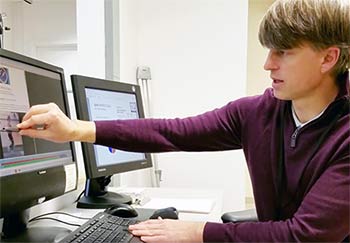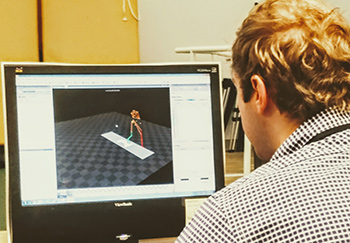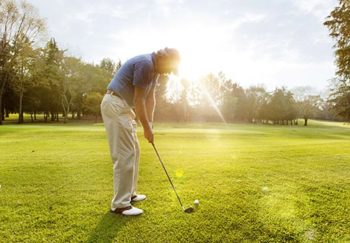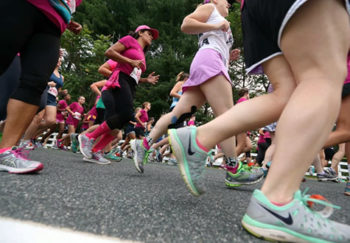
How to run faster: It’s a question many runners obsess over. But for many people, runners and nonrunners alike, a more prevalent question is this: Will I ever run again without pain? Whatever the question you have about running, odds are, you can get the answer here, with a high-tech running analysis at the UVA Speed Clinic.
Why a Running Analysis?
Whether it’s “competitive athletes who want to qualify for competitive trials or grandparents who want to keep up with their grandkids, they all come here,” Michael Myers, web specialist and biomechanical research assistant, tells me. He’s one of three team members who helps conduct the assessment.
The Speed Clinic itself looks like a cross between a gym and a film studio. Balls and bats cram together on a wall. Mounted cameras look down on a treadmill that’s flush with the green floor.
Max Prokopy, the biomechanical assessment specialist who heads the clinic, casually explains that this facility has an international reputation for personal attention and expertise. “People from all over the world come here for a running analysis. We’ve had people from Russia, South America, Germany, pretty much anywhere. Olympic teams from Ecuador, Chile, Argentina, UK, Italy.”
Mostly, visitors come for a single assessment. But this is no drive-through service. “It takes time. When you go see a physician, you get 30 minutes at most. With us you’re going to get 2-3 hours, so it gives us time to look through everything. To do a good job, it takes time,” Prokopy says.
And this is the clinic’s specialty: Discovering the source of injury that’s proved a mystery to other providers. “We see a lot of people who are at the end of their rope. They’re really tired of being hurt in a certain area. They’ve gone to physical therapy. That stuff’s been exhausted.”
Runners view the Speed Clinic as a last hope.
Force Analysis & Running Injury

Ever since the advent of cameras, Prokopy explains, runners have been using technology to improve their running. “People would set up grids and take still shots against the grid, then calculate angles while people were walking.”
While these techniques could provide basic motion analysis, they could not measure forces.
Today, more sophisticated technology and expertise allows for force analysis, which attempts to understand the impact of running on the body. “If you know how much total force you’re using, and look at how much the joint has moved, you can actually look at the individual force on your joint,” Prokopy explains.
What causes force? Force = mass x acceleration. The key to running faster is to apply more force over the longest distance.
But, the more force you apply, the more your tissues —muscles, tendons, ligaments — have to withstand that force. And that’s what leads to a running injury.
Assessing Running Injury with Animation
What makes the Speed Clinic such a unique facility and service is that they’re able to put it all together with video and proprietary software. Together, this technology captures amazing amounts of data while a runner is in motion.
“We try to put everything together. The simple way to put it is, when you run, you have to handle 2.5 times your body weight on one foot every time you stride, and so that adds up to stress in places. That’s why runners get hurt.”
The Speed Clinic calculations get extremely precise. “We can say when a particular pair of shoes changes the torque at your knee, not at your ankle.” This type of very specific information can prove critical to a runner trying to heal or speed up.

How to Run Faster: Fix Your Running Stride
For each runner who comes into be evaluated, the clinic team videos the runner on a treadmill, then creates a custom animation — a virtual version of the person — that allows for the in-depth data extraction of all their joint angles. The report shows the movements of all joints in 3D.
Runners come away with pages and pages of data, in colorful charts and graphs, showing their:
- Overall mechanical efficiency
- Braking force
The charts and graphs detail the runner’s every move.
But the clinic doesn’t just offer analysis of a running injury. “We have to identify where that takes place and figure out why that takes place and come up with things to do about it.”
Don’t Miss Part 2 of this Story
Sign up for the weekly blog email now!
Once they pinpoint what’s preventing a runner from recovering or increasing speed, they offer exercises, shoe recommendations and other in-depth advice to help address a person’s personal obstacles.
How does this work? Tomorrow, one of our colleagues describes what she learned about her running stride as she prepares for the Charlottesville Ten Miler race.


Would be very interested in this assessment! How much does it cost? Have been limited in distance running due to IT band issues.
Hi Carol, The 3D is $375; 2D is $200. Take a look at these FAQs for more info. Good luck!